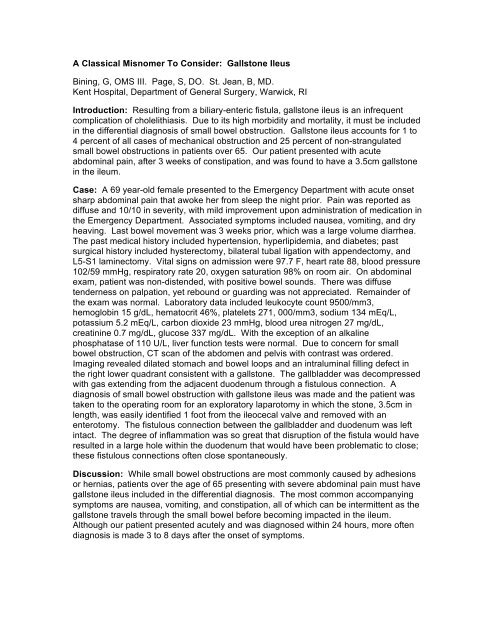Acute Flaccid Paralysis Accompanying West Nile Meningitis Ahmed ...
Acute Flaccid Paralysis Accompanying West Nile Meningitis Ahmed ...
Acute Flaccid Paralysis Accompanying West Nile Meningitis Ahmed ...
Create successful ePaper yourself
Turn your PDF publications into a flip-book with our unique Google optimized e-Paper software.
A Classical Misnomer To Consider: Gallstone Ileus<br />
Bining, G, OMS III. Page, S, DO. St. Jean, B, MD.<br />
Kent Hospital, Department of General Surgery, Warwick, RI<br />
Introduction: Resulting from a biliary-enteric fistula, gallstone ileus is an infrequent<br />
complication of cholelithiasis. Due to its high morbidity and mortality, it must be included<br />
in the differential diagnosis of small bowel obstruction. Gallstone ileus accounts for 1 to<br />
4 percent of all cases of mechanical obstruction and 25 percent of non-strangulated<br />
small bowel obstructions in patients over 65. Our patient presented with acute<br />
abdominal pain, after 3 weeks of constipation, and was found to have a 3.5cm gallstone<br />
in the ileum.<br />
Case: A 69 year-old female presented to the Emergency Department with acute onset<br />
sharp abdominal pain that awoke her from sleep the night prior. Pain was reported as<br />
diffuse and 10/10 in severity, with mild improvement upon administration of medication in<br />
the Emergency Department. Associated symptoms included nausea, vomiting, and dry<br />
heaving. Last bowel movement was 3 weeks prior, which was a large volume diarrhea.<br />
The past medical history included hypertension, hyperlipidemia, and diabetes; past<br />
surgical history included hysterectomy, bilateral tubal ligation with appendectomy, and<br />
L5-S1 laminectomy. Vital signs on admission were 97.7 F, heart rate 88, blood pressure<br />
102/59 mmHg, respiratory rate 20, oxygen saturation 98% on room air. On abdominal<br />
exam, patient was non-distended, with positive bowel sounds. There was diffuse<br />
tenderness on palpation, yet rebound or guarding was not appreciated. Remainder of<br />
the exam was normal. Laboratory data included leukocyte count 9500/mm3,<br />
hemoglobin 15 g/dL, hematocrit 46%, platelets 271, 000/mm3, sodium 134 mEq/L,<br />
potassium 5.2 mEq/L, carbon dioxide 23 mmHg, blood urea nitrogen 27 mg/dL,<br />
creatinine 0.7 mg/dL, glucose 337 mg/dL. With the exception of an alkaline<br />
phosphatase of 110 U/L, liver function tests were normal. Due to concern for small<br />
bowel obstruction, CT scan of the abdomen and pelvis with contrast was ordered.<br />
Imaging revealed dilated stomach and bowel loops and an intraluminal filling defect in<br />
the right lower quadrant consistent with a gallstone. The gallbladder was decompressed<br />
with gas extending from the adjacent duodenum through a fistulous connection. A<br />
diagnosis of small bowel obstruction with gallstone ileus was made and the patient was<br />
taken to the operating room for an exploratory laparotomy in which the stone, 3.5cm in<br />
length, was easily identified 1 foot from the ileocecal valve and removed with an<br />
enterotomy. The fistulous connection between the gallbladder and duodenum was left<br />
intact. The degree of inflammation was so great that disruption of the fistula would have<br />
resulted in a large hole within the duodenum that would have been problematic to close;<br />
these fistulous connections often close spontaneously.<br />
Discussion: While small bowel obstructions are most commonly caused by adhesions<br />
or hernias, patients over the age of 65 presenting with severe abdominal pain must have<br />
gallstone ileus included in the differential diagnosis. The most common accompanying<br />
symptoms are nausea, vomiting, and constipation, all of which can be intermittent as the<br />
gallstone travels through the small bowel before becoming impacted in the ileum.<br />
Although our patient presented acutely and was diagnosed within 24 hours, more often<br />
diagnosis is made 3 to 8 days after the onset of symptoms.

















